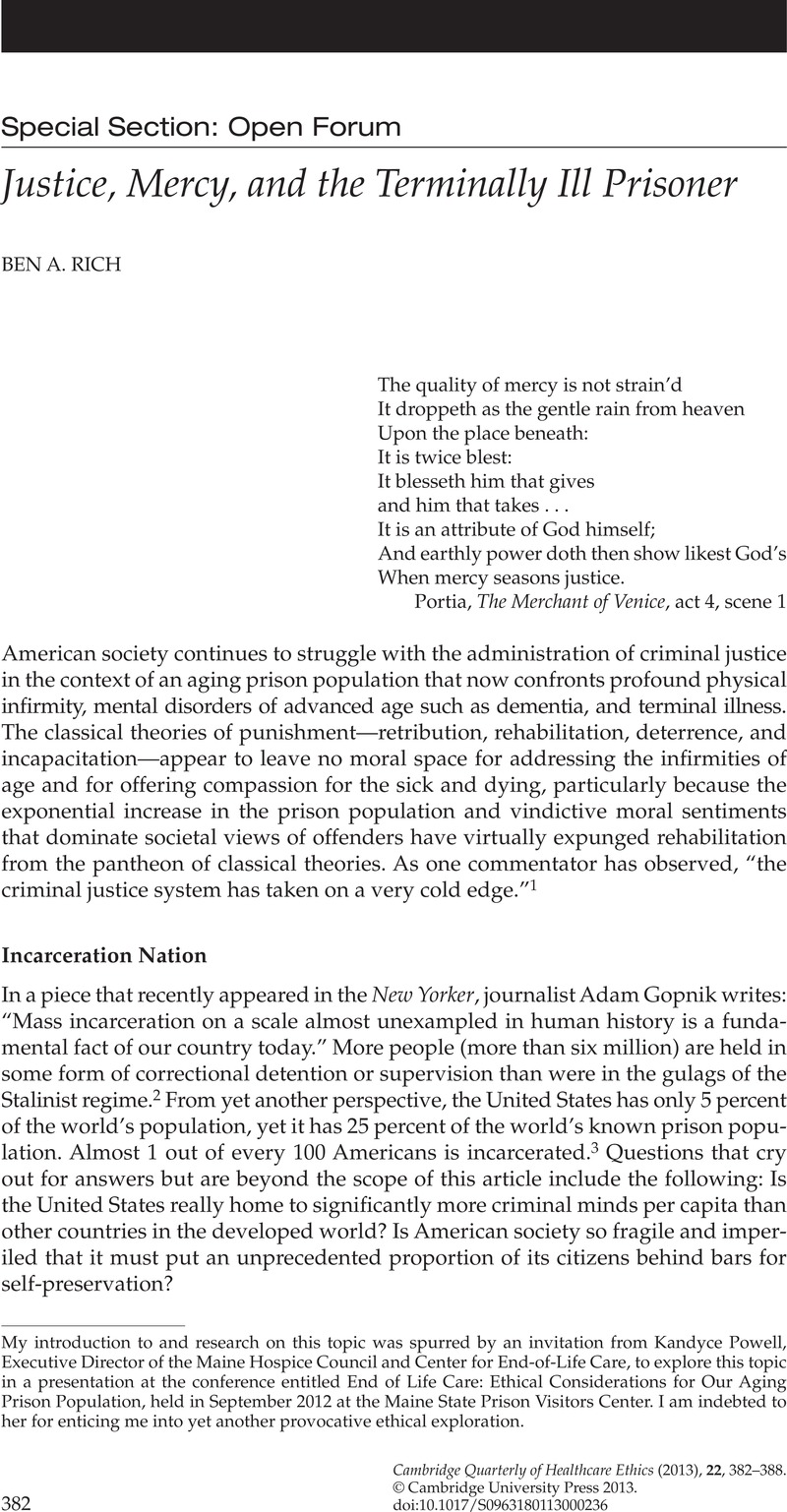Article contents
Justice, Mercy, and the Terminally Ill Prisoner
Published online by Cambridge University Press: 06 August 2013
Abstract

- Type
- Special Section: Open Forum
- Information
- Copyright
- Copyright © Cambridge University Press 2013
References
Notes
1. Misner, RL. A strategy for mercy. William and Mary Law Review 2000;41:1303–99, at 1303.Google Scholar
2. Gopnik, A. The caging of America. The New Yorker 2012;87:72–77, at 72.Google Scholar
3. Zakaria, F. Incarceration nation. Time 2012;179, at 8.Google Scholar
4. Mauer, M.Race to Incarcerate. 2nd ed. New York: The New Press; 2006, at 10.Google Scholar
5. See note 1, Misner 2000, at 1303.
6. Editorial Board. Time to end the fiction of California’s death penalty. The Sacramento Bee 2012 Sep 9:E6.
7. American Civil Liberties Union. At America’s Expense: The Mass Incarceration of the Elderly. New York: American Civil Liberties Union; 2012, at V.Google Scholar
8. See note 7, American Civil Liberties Union 2012, at V.
9. Shields, KE, deMoya, D. Correctional health care nurses’ attitudes toward inmates. Journal of Correctional Health Care 1997;4:37–59.Google Scholar
10. Estelle v. Gamble, 429 U.S. 97, 104-5 [1976].
11. Fea, J. Was America Founded as a Christian Nation? Louisville, KY: Westminster John Knox Press; 2011.Google Scholar
12. Matthew, 25: 34–40. The King James Study Bible. Nashville, TN: Thomas Nelson; 1988.Google Scholar
13. Williams T. Saint Anselm. The Stanford Encyclopedia of Philosophy (Spring 2011 Edition). Zalta EN, ed.; available at http://plato.stanford.edu/archives/spr2011/entries/anselm/ (last accessed 10 Nov 2012).
14. Smart A. Mercy. Philosophy 1968;43:345–59.
15. Card C. On mercy. The Philosophical Review 1972;81:182–207, at 182.
16. Murphy, JG, Hampton, J. Forgiveness and Mercy. New York: Cambridge University Press; 1988, at 167.CrossRefGoogle Scholar
17. Bennett, C. The limits of mercy. Ratio 2004;17:1–11, at 5.Google Scholar
18. Steiker, CS. Tempering or tampering? Mercy and the administration of criminal justice. In: Sarat, A, Hussain, N, eds. Forgiveness, Mercy, and Clemency. Stanford, CA: Stanford University Press; 2007:16–35, at 16.Google Scholar
19. See note 15, Card 1972, at 203.
20. Dubler, NN, ed. Standards for Health Services in Correctional Institutions. 2nd ed. Washington, DC; 1986.Google Scholar
21. Cohn, F. The ethics of end-of-life care for prison inmates. Journal of Law, Medicine & Ethics 1999;27:252–8.CrossRefGoogle ScholarPubMed
22. Ratcliff, M, Craig, E. The GRACE project: Guiding end-of-life care in corrections: 1998–2001. Journal of Palliative Medicine 2004;7:373–9.CrossRefGoogle ScholarPubMed
23. National Hospice and Palliative Care Organization. Quality Guidelines for Hospice and End-of-Life Care in Correctional Settings; 2009; available at http://www.nhpco.org/files/public/access/corrections/CorrectionsQualityGuidelines.pdf (last accessed 12 Nov 2012).
24. Evans, C, Herzog, R, Tillman, T. The Louisiana State Penitentiary: Angola Prison Hospice. Journal of Palliative Medicine 2002;5:553–8.CrossRefGoogle ScholarPubMed
25. Byock, IR. Dying well in corrections: Why should we care? Journal of Correctional Health Care 2002;9:107–17.Google Scholar
26. 18 U.S.C. §3582 (c) (1) (A) 2006.
27. Berry, WW 3rd. Extraordinary and compelling: A re-examination of the justifications for compassionate release. Maryland Law Review 2009;68:850–88.Google Scholar
28. Williams, BA, Sudore, RL, Greifinger, R, Morrison, RS. Balancing punishment and compassion for seriously ill prisoners. Annals of Internal Medicine 2011;155:122–6.CrossRefGoogle ScholarPubMed
- 3
- Cited by


